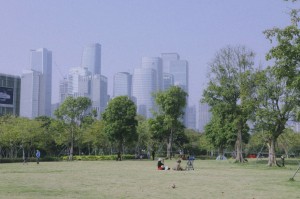One of the biggest challenges with cities is they typically have poor climate resilience. All that concrete, stone, steel, glass, tarmac, and asphalt creates major challenges with flooding, and heat. We need creative solutions to address the danger. This can involve massive changes to homes, commercial architecture, infrastructure, and more.
An interesting idea that is gaining a lot of popularity is “sponge cities”. In fact, it became national policy in China back in 2013. In the last few decades we’ve seen a number of different projects around the world. They work to make cities more resilient to flooding by improving water management. Let’s have a closer look.
The concept
 The idea with sponge cities is they look at alternatives to non-permeable materials and grey infrastructure. Instead, they use more nature based solutions such as wetlands and rain gardens. The goal is to absorb, filter, and store water rather than it gathering on hard services or having to go through traditional drainage systems.
The idea with sponge cities is they look at alternatives to non-permeable materials and grey infrastructure. Instead, they use more nature based solutions such as wetlands and rain gardens. The goal is to absorb, filter, and store water rather than it gathering on hard services or having to go through traditional drainage systems.
There are a number of advantages with sponge cities. Firstly, they can massively reduce the risk of flooding, protecting homes, commercial architecture, and infrastructure. Rigid drainage systems can struggle to handle large volumes of water; they generally weren’t designed to deal with it in the first place. Plus, they can easily have problems with blockages. Alternative methods can deal with higher volumes of water and have fewer potential issues.
According to a study by the University of Leeds, sponge city strategies are also more cost effective. A project in Wuhan, China, was 4 billion yuan (close to $600m) cheaper than a traditional grey infrastructure approach. Additionally, it helps reduce ongoing costs for things like watering plants and maintenance.
Finally, the sponge city strategy is more sustainable. It can manage water for more effectively, storing, filtering, or diverting it for various uses. That is crucial in areas where water shortages are, or may become, commonplace.
Three strategies
Sponge cities can use a number of different strategies, but they typically fall into one of three categories. It is important to think carefully about them and which will work best. Consider the impact on homes, commercial architecture, and the people that live in the area.
One option is to look at ways to absorb water. The most common option is to replace hardscape materials with porous surfaces, including soil or permeable materials. They ensure more resilience against flooding because water can soak in rather than gathering on the surface.
The second method is to store water effectively for other uses. There are some interesting ideas here, including urban parks and wetlands that are designed to flood. They store water rather than discharging it elsewhere, reducing the risk of flooding. It protects the city and also ensures the resources are available for dry periods.
Finally, there are strategies to filter water. Filtration can turn dirty water into a viable resource for various needs. It can also clean it to allow safer discharge into surrounding environments. Some great ideas here are to use natural filtering processes like vegetation and gravel beds. They are more sustainable than energy consuming mechanical treatments.
Discuss any aspect of commercial architecture with us
Coffey Architects knows how important climate resilience is, especially with flooding becoming a more common issue in cities all around the world. It is important to look at different strategies, including ways to absorb, filter, and store water. They can protect the city, improve life for residents, and even offer economical benefits.
If you are thinking of a project, especially commercial architecture, we’d love to help. We can look at different options for every part of a site, including rain gardens and more. So, contact us today and let us know what you have in mind.